The documentation from version 39.5.17 of PLANTA project can be found in the new PLANTA Online Help .
.
TWiki> CurrentEN Web>UserDocumentation>UserWorkflowsTutorials>BudgetWorkflowExamples>BudgetWorkflowExamplesFromDB3950
CurrentEN Web>UserDocumentation>UserWorkflowsTutorials>BudgetWorkflowExamples>BudgetWorkflowExamplesFromDB3950
Budget Workflow Examples From DB 39.5.0 up to DB 39.5.6
Please note- The following workflow applies to database versions 39.5.0 to 39.5.6.
- The following table contains links to the other versions:
| DB 39.5.14 | go to the tutorial |
| DB 39.5.7 - DB 39.5.13 | go to the tutorial |
| DB 39.5.0 - DB 39.5.6 | go to the tutorial |
| go to further tutorials |
- The project manager creates a schedule, assigns resources and allocates the effort. Subsequently he/she carries out the capacity scheduling.
- In the Models and Model Parameters, the Manual cost input parameter is deactivated. This means: *During capacity scheduling, costs are automatically calculated on the basis of conversion factors of the resources and allocated to the respective cost type groups.
- In the Budget module, the calculated costs are displayed allocated to the cost type groups. In this module, the project manager can request the budget on the basis of calculated costs and the multi-project manager (or another person that has the respective rights) can approve the budget.
Model 1
Information- In model 1, the following parameters are defined for all examples:
-
p_project_budget_approved_edit= bottom up -
p_project_budget_edit= open
-
Example 1: Simple project with runtime < 1 year
Schedule exampleProcedure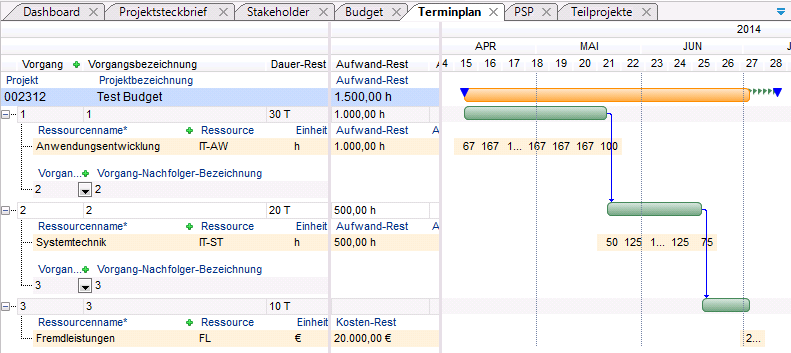
- The calculated costs are displayed in the yearly tranche of the current year and summarized upwards to project level.
- Request
- The project manager requests the budget by copying the costs from the Remaining costs current column to the Requested current column on the yearly tranche of the current year.
- The splitting of the budgets over several years is not necessary in this example since the project has a runtime of less than one year.
- Subsequently, he/she clicks on the Recalculate button. The values are summarized from the yearly tranche to project level.
- The project manager requests the budget by copying the costs from the Remaining costs current column to the Requested current column on the yearly tranche of the current year.
- Approval
- The multi-project manager approved the requested budget by copying the values from the Requested current column to the Approved current column.
- For this purpose, he/she clicks on the arrow above the Approved current column.
- The values of the Requested current column are transferred to the Requested current column automatically.
- For this purpose, he/she clicks on the arrow above the Approved current column.
- The multi-project manager approved the requested budget by copying the values from the Requested current column to the Approved current column.
- The multi-project manager clicks on the green checkbox next to the Costs yearly tranche heading and subsequently on the Recalculate button.
- By doing so, he/she approves the budget of this yearly tranche.
- The Approved current column in the yearly tranche is set to "output", which means that the values of this yearly tranche can no longer be edited.
- The Approved current values of the yearly tranche are summarized to project level.
- Afterwards, the multi-project manager copies the values from the Approved current column to the Budget current column by clicking on the arrow above the Budget current column. Subsequently he/she saves and clicks on the Recalculate button.
- The values are automatically copied from the Approved current column to the Budget current column on the yearly tranche and summarized on project level.
- The Budget total column is automatically filled with the summarized values from the current project and all of its subprojects. Since the current project has no subprojects, the values in this column are eual to those in the Budget current column.
Example 2: Structured project with runtime < 1 year
Schedule example- The case described here is a main project with two subprojects.
- The schedule of the main project has no resource assignments. I.e. no cost planning is done.
- The entire planning is done in the subprojects.
Procedure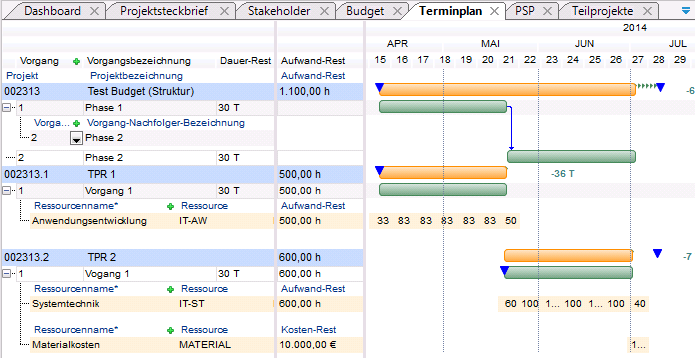
- In the Budget module, the main project and all of its subprojects are displayed.
- Open the _Overall View (current+total) module variant.
- The calculated costs are visualized in the Costs remaining column in the yearly tranche of the current year for each subproject and summarized upwards to the project level of each subproject (Costs sum line in the respective subproject).
- The Remaining costs current column on the main project is empty since the main project has no own costs.
- The structure summarization is done in the Remaining costs total column (black arrows on the screenshot below). Since the subprojects in our example contain no further subprojects, the values in the Remaining costs and Remaining costs total columns are equal.
- The summarized values from the Remaining costs total column are summarized from the subprojects to the main project (blue arrows on the screenshot).
- On the following screenshots, some columns in the Budget module are hidden or their sequence has been changed for reasons of clarity of the screenshots, so that their actual display may deviate from that on the screenshots.
- The request and approval of the budget is done in the individual subprojects.
- The procedure here is equal to that of example one. See above.
- As soon as the Budget current column in the subprojects is filled and the Recalculate button was clicked on, the values are summarized to the Subprojects and Budget total columns on the main project. Since the main project has no own Budget current, the values in the Subprojects and Budget total collumns are equal.
Example 3: Simple project with runtime > 1 year
Schedule example- The runtime of the project amounts to about 5 months in the current year and three months in the following year.
- In both years, effort incurs.
Procedure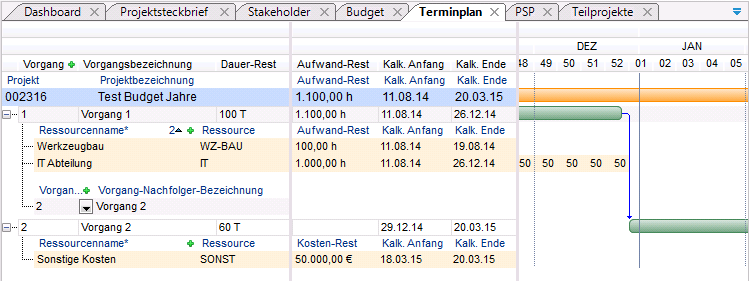
- The calculated costs are allocated to year tranches automatically and displayed, and summarized to main project level (according to the distribution of effort to the years).
- Request
- The project manager requests the budget by copying the costs from the Remaining costs column to the Requested current column in each yearly tranche.
- Approval
- The multi-project manager transfers the values from the :Requested current_ column to the Approved current column by clicking on the arrow above the Approved current column.
- The values of the Requested current column are transferred to the Requested current column automatically.
- The multi-project manager clicks on the green checkbox next to the Costs heading of the yearly tranches which he/she wants to approve, and subsequently he/she clicks on the Recalculate button.
- As a result, the budget in the Approved current column is approved for the respective years.
- The column in the respective yearly tranche is grayed out, which means that the values of this column cannot be edited.
- The values of all approved yearly tranches are summarized to project level.
- The multi-project manager transfers the values from the :Requested current_ column to the Approved current column by clicking on the arrow above the Approved current column.
If, as in this case for example, the budget of the year 2014 is approved, only the values of this yearly tranche is summarized upwards to project level.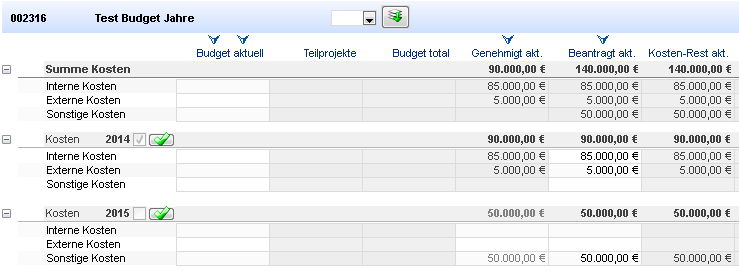
If all yearly tranches are approved, the values of all yearly tranches are summarized upwards to project level.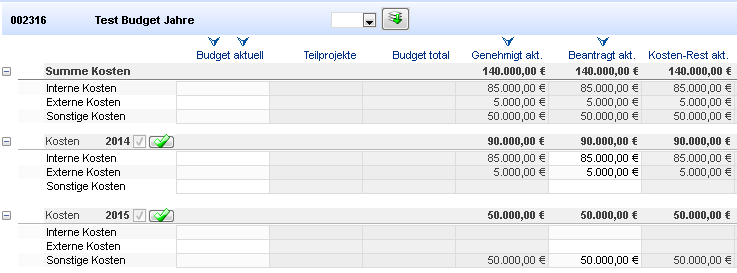
- Afterwards, the multi-project manager copies the values from the Approved current column to the Budget current column by clicking on the right arrow above the Budget current column, and subsequently clicking on the Recalculate button.
- The values of the Budget current column are summarized upwards from all approved yearly tranches to project level.
Example 4: Structured project with runtime > 1 year
Schedule example- The case described here is a main project with two subprojects.
- The runtime of the entire project extends over the current and the follwoing year. As a result, the runtime and the respective effort of TPR 1 mainly extend over the current year and only negligibly over the following one. The runtime of TPR 2 and the respective effort extends completely over and is limited to the following year.
- The schedule of the main project has no resource assignments. I.e. no cost planning is done.
- The entire planning is done in the subprojects.
Procedure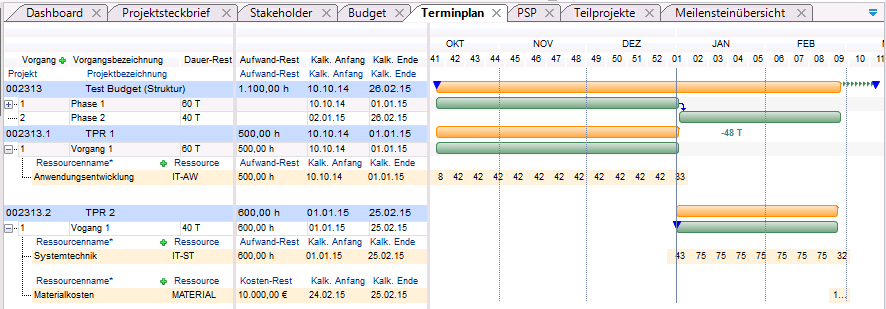
- The calculated costs are automatically allocated to several yearly tranches (according to the distribution of effort to years) and are displayed in the Remaining costs current and Remaining costs current in each subproject and summarized upwards to the main project level.
| I | Attachment | History | Size | Date | Comment |
|---|---|---|---|---|---|
| |
BudgetBSP1.1.PNG | r1 | 16.6 K | 2014-03-27 - 15:16 | |
| |
BudgetBSP1.2.PNG | r1 | 17.8 K | 2014-03-27 - 15:16 | |
| |
BudgetBSP1.3.PNG | r1 | 18.8 K | 2014-03-27 - 15:16 | |
| |
BudgetBSP1.4.PNG | r1 | 18.1 K | 2014-03-27 - 15:16 | |
| |
BudgetBSP1.5.PNG | r1 | 21.5 K | 2014-03-27 - 15:17 | |
| |
BudgetBSP2.1.PNG | r1 | 21.2 K | 2014-03-24 - 17:25 | |
| |
BudgetBSP2.10.PNG | r1 | 51.4 K | 2014-03-25 - 17:21 | |
| |
BudgetBSP2.2.PNG | r1 | 22.3 K | 2014-03-24 - 17:25 | |
| |
BudgetBSP2.20.PNG | r1 | 54.4 K | 2014-03-27 - 15:57 | |
| |
BudgetBSP2.3.PNG | r1 | 21.5 K | 2014-03-24 - 17:25 | |
| |
BudgetBSP2.30.PNG | r1 | 57.7 K | 2014-03-26 - 15:57 | |
| |
BudgetBSP2.4.PNG | r1 | 22.6 K | 2014-03-24 - 17:38 | |
| |
BudgetBSP3.1.PNG | r1 | 15.8 K | 2014-03-27 - 00:32 | |
| |
BudgetBSP3.2.PNG | r1 | 17.0 K | 2014-03-27 - 00:32 | |
| |
BudgetBSP3.3.PNG | r1 | 17.0 K | 2014-03-27 - 00:33 | |
| |
BudgetBSP3.4.PNG | r1 | 21.3 K | 2014-03-27 - 00:33 | |
| |
BudgetBSP4.1.PNG | r1 | 70.0 K | 2014-03-31 - 12:22 | |
| |
Terminplan1.PNG | r1 | 35.0 K | 2014-03-27 - 15:17 | |
| |
Terminplan2.PNG | r2 r1 | 34.2 K | 2014-03-27 - 16:43 | |
| |
Terminplan3.PNG | r2 r1 | 30.8 K | 2014-03-27 - 16:47 | |
| |
Terminplan4.PNG | r1 | 39.1 K | 2014-03-31 - 12:22 |


